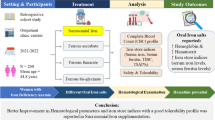Abstract
PURPOSE: This study was designed to investigate the development of anemia during functional ileoanal pouch. METHODS: Eighty-three patients received an ileoanal pouch between 1980 and 1987. The hematology data deviations among the preoperative period, defunctionalized stage, and after ileal pouch in function were monitored. Aspects studied included serum hemoglobin, iron, folates, vitamin B12, white blood cell, erythrocyte sedimentation rate, pt-B12, and fat absorption. Specimens were collected before colectomy, during ileostomy prior to pouch operation, before loop ileostomy closure, and at 6, 12, 18, 24, and 36 months after loop ileostomy closure. RESULTS: Two patients developed iron deficiency anemia after 2.5 and 5 years of pouch function: one patient, a vegetarian, had low hemoglobin, iron, and vitamin B12 postoperatively, the other patient developed low iron and hemoglobin 5 years after the operation. Significant elevations of serum hemoglobin, iron, and folates were seen preoperativelyvs postoperatively from 12346±2.845 g/l, 10.282±0.992 μmol/l, and 9.983 ±1.308 mmol/l to 138.842±1.563 g/l (P<0.0001), 17.544±1.529 μmol/l (P<0.0003), and 16.784±1.757 mmol/l (P<0.01) (mean±SE) of the defunctionalized loop ileostomy. Serum B12 decreased insignificantly. After loop ileostomy closure, at 6 and 36 months of functional ileal pouch-anal anastomosis, the elevations were still siginificant; serum hemoglobin wasP<0.0001 and P<0.01, and serum iron was P<0.001 and P< 0.01, respectively. Vitamin B12 levels decreased insignificantly at six months in controls and significantly (P< 0.01) at 36 months. There was a significant increase of serum folates (P<0.01 and P<0.001). Patients with low iron were 50 percent at precolectomy, 23 percent with ileostomy, 16 percent with loop ileostomy, 15 percent at six-month follow-up, and 11 percent at 12-month follow-up. Although only 3 percent and 11 percent of the patients with ileal pouch-anal anastomosis had low serum vitamin B12 values at the 12-month and 36-month follow-up, 31 percent and 36 percent had decreased Schilling tests. Thirty-three percent and 41 percent had decreased14C-triolein breath tests. In five patients vitamin B12 deficiency began during the first six months of pouch function: in two patients after one year and in one patient after two years. Eight of 83 patients have had substitution therapy with vitamin B12. The therapy was discontinued in three patients after two to four years; these patients developed no further symptoms and had normal Schilling tests in the succeeding 30 months to 46 months. Five patients continue with substitution after 40 months to 68 months. During the functional period, serum erythrocyte sedimentation rate and white blood cells were elevated in some controls on different occasions. Folates were normal throughout the functional period. CONCLUSION: For predicting hematologic data outcome in patients with functional ileal reservoir, the results justify the necessity for control during both manipulative and functional periods until evaluations are reliable and satisfying.
Similar content being viewed by others
References
Clark AC, Booth CC. Deficiency of vitamin B12 after extensive resection of the distal small intestine in an infant. Arch Dis Child 1960;35:595–9.
Moore CV. Iron metabolism and nutrition. Harvey Lect 1961;55:67–101.
Naiman JL, Oski FA, Diamond LK,et al. The gastrointestinal effects of iron deficiency anemia. Pediatrics 1964;33:83–99.
Moore CV, Duback R. Metabolism and requirements of iron in the human. JAMA 1956;162:197–204.
Booth CC, Mollin DL. The site of absorption of vitamin B12 in man. Lancet 1959;1:18–21.
Seetharam B, Alpers DH. Absorption and transport of cobalamin (vitamin B12). Ann Rev Nutr 1982;2: 343–69.
Jagenburg R, Kock NG, Phillipson B. Vitamin B12 absorption in patients with continent ileostomy. Gut 1971;12:437–41.
Coyle JJ, Varco RL, Buchwald H. Vitamin B12 absorption following human intestinal bypass surgery. Am J Dig Dis 1977;22:1069–71.
Payne JH, DeWind LT. Surgical treatment of obesity. Am J Surg 1969;118:141–7.
Hulten L, Kewenter J, Persson E, Ahren C. Vitamin B12 absorption in ileostomy patients after operation for ulcerative colitis. Scand J Gastroenterol 1970;5: 113–6.
Schjonsby H, Halvorsen JF, Hofstand T, Hovdennak N. Stagnant loop syndrome in patients with continent ileostomy (intra-abdominal ileal reservoir). Gut 1977;18:795–9.
Herbert V. Transient (reversible) malabsorption of vitamin B12. Br J Haematol 1969;17:213–9.
Bondar GF, Pisesky N. Complications of small intestinal short circuiting for obesity. Arch Surg 1967;94: 707–16.
Booth CC. The metabolic effects of intestinal resection in man. Postgrad Med 1961;37:725–39.
Shibata HR, Machenzie JR, Long RC. Metabolic effects of controlled jejunocolic bypass. Arch Surg 1967;95:413–27.
Dano P, Lenz K. Changes of bile acids and absorption of vitamin B12 after intestinal shunt operation in obesity. A comparison of three types of operation. Scand J Gastroenterol 1974;9:451–5.
Booth CC, MacIntyre I, Mollin DL. Nutritional problems associated with extensive lesions of the distal small intestine in man. Q J Med 1964;33:401–20.
Juhl E, Bruusgaard A, Hippe E, Korner B, Quaade F, Baden H. Vitamin B12 Scand J Gastroenterol 1974;9:643–7.
Philipson B, Brandberg Å, Jagenburg R, Kock NG, Lager I, Åhrén C. Mucosal morphology, bacteriology and absorption in intra-abdominal ileostomy reservoir. ScandJ Gastroenterol 1975;10:145–53.
Gorbach SL, Nahas L, Lerner PI, Weinstein L. Studies of intestinal microflora. Gastroenterology 1967;53: 845–55.
Fonkalsrund EW. Endorectal ileoanal anastomosis with isoperistaltic ilealreservoir after colectomy and mucosal proctectomy. Ann Surg 1984;199:151–7.
Dozois RR, Goldberg SM, Rothenberger DA,et al. Restorative proctocolectomy with ileal reservoir. Int J Colorectal Dis 1986;1:2–19.
Dozois RR. Ileal “J” pouch-anal anastomosis. Br J Surg 1985;72:80–2.
Moskowitz RL, Shepherd NA, Nicholls RJ. An assessment of inflammation in the reservoir after proctocolectomy with ileoanal ileal reservoir. Int J Colorectal Dis 1986;1:167–74.
Liljeqvist L, Lindquist K, Ljungdahl I. Alterations in ileoanal pouch technique, 1980 to 1987: complications and functional outcome. Dis Colon Rectum 1988;31:929–38.
Tytgat GN, Deventer SJ. Pouchitis. Int J Colorectal Dis 1988;3:226–8.
Author information
Authors and Affiliations
About this article
Cite this article
M'Koma, A.E., Marino, A.W.M. Follow-up results of hematology data before and after restorative proctocolectomy. Dis Colon Rectum 37, 932–937 (1994). https://doi.org/10.1007/BF02052601
Issue Date:
DOI: https://doi.org/10.1007/BF02052601




